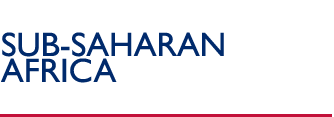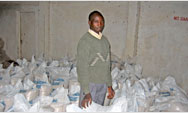Namibia
OVERVIEW
In its first 18 years of independence, Namibia has made impressive progress establishing a free, viable nation. Few other countries in Africa invest as much in the education and health of their people; its press is one of the most free; and it has one of the highest "business competitiveness" rankings and the lowest levels of corruption. However, Namibia is confronted by two formidable challenges: controlling one of the world's worst HIV/AIDS epidemics and correcting the world's worst income disparity that leaves far too many in poverty. Namibia has one of the highest income disparities in the world; the gross domestic product averages $2,166 a person, but fully a third of Namibians survive on less than a dollar a day. USAID has provided over $299 million to Namibia since 1991 to help overcome these challenges.
PROGRAMS
INVESTING IN PEOPLE: HEALTH
To respond to one of the worst HIV/AIDS epidemics and the highest tuberculosis case rate in the world, the United States provided nearly $49 million to Namibia in 2008 through the U.S. President's Emergency Plan for AIDS Relief. USAID's programs focus on providing care and services to orphans and vulnerable children, reducing the spread of HIV, and supporting Namibia's national tuberculosis program. USAID has funded palliative care for 26,866 people and services to 45,304 vulnerable children. Five hospitals and 51 health centers provided anti-retroviral treatment and services to prevent mother-to-child transmission of HIV, and 53,507 clients received counseling and testing at 14 centers. USAID also launched a program to treat and care for those co-infected with tuberculosis and HIV/AIDS.
INVESTING IN PEOPLE: EDUCATION
With two-thirds of Namibia's sixth grade students lacking needed reading and math skills, USAID is helping improve teaching quality of core subjects in grades 1-7. In 2008, pilot trainings provided to teachers, administrators, and school boards and parents, was so successful that the Namibian government decided to replicate it nationwide. This intensive teacher training led to an 8 percent average improvement in student performance in targeted regions. USAID also helps increase the capacity of the Ministry of Education to establish and implement effective, equitable HIV/AIDS policies with an emphasis on teacher shortages and increases in the number vulnerable children.
More than 70 percent of Namibians reside in rural areas, many in poverty, depending on natural resources for their livelihoods. Over the last 15 years, USAID assistance has helped build a nationwide conservation and rural development movement that involves one out of every eight Namibian citizens. Since the inception of the program, 52 conservancies were established covering 16.5 percent of Namibia's landmass and benefiting 254,000 previously disadvantaged Namibians. Annual member benefits from the conservancy reached more than $5.5 million, and 17 conservancies are now fully self-sustaining. The conservancies have created 946 full-time jobs, 6,200 part-time jobs, and 108 small and medium-sized enterprises. Namibia's wildlife is now valued and managed as a communal asset-an attitude that has resulted in dramatic progress unparalleled in Africa.
Back to Top ^
|


